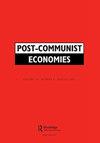家庭储蓄率与GDP之间的联系:来自Visegrád小组的证据
IF 1.8
3区 经济学
Q2 ECONOMICS
引用次数: 0
摘要
摘要在过去的二十年中,两个全球性事件突出了家庭储蓄对经济和个人的重要性,以及它们与经济活动和增长的关系。首先,2008年的全球金融危机提醒世界,家庭储蓄对经济复苏和可持续经济发展至关重要。其次,最近的COVID-19大流行表明,家庭储蓄在各种外部冲击面前是多么脆弱。本文研究了1996-2021年期间,Visegrád集团的四个国家,即捷克共和国、匈牙利、波兰和斯洛伐克的家庭储蓄率与实际GDP之间的关系。我们的实证分析表明,在捷克共和国和匈牙利,实际GDP与家庭储蓄率、家庭储蓄率与实际GDP之间存在短期格兰杰因果关系。此外,我们还报告了家庭储蓄率和实际GDP之间显著的长期关系,特别是在匈牙利。关键词:SavingsGDPVisegrád群体协整向量误差修正模型致谢作者感谢两位匿名评论者的有益评论。这项研究得到了斯洛伐克共和国J. William Fulbright教育交流委员会、斯洛伐克教育、科学、研究和体育部科学资助机构以及斯洛伐克科学院的支持,项目为VEGA 1/0646/2023。内容是作者的唯一责任,并不一定反映上述实体的官方观点。披露声明作者未报告潜在的利益冲突。数据可用性声明数据可根据要求从作者处获得。在2020年前两个季度,储蓄率急剧上升。更具体地说,它在第一季度上升了约5个百分点,在第二季度上升了约12% (Dossche & Zlatanos, Citation2020)。捷克共和国的家庭储蓄率约为21.1%,而波兰、匈牙利和斯洛伐克的家庭储蓄率分别约为8.8%、15.1%和10.9% (Eurostat, Citation2021b)。参见Caudill et al. (Citation2020)进行更广泛的讨论。支持储蓄率和GDP研究的主要论点之一是,储蓄在提高GDP方面发挥着重要作用(Aghion等人,Citation2016;Botev等人,Citation2019)。家庭储蓄也被认为是经济发展的核心(Sekantsi & Kalebe, Citation2015;Gross et al., Citation2020)。一些研究同时分析了发达国家和发展中国家储蓄与GDP之间的联系(例如Brueckner等人,Citation2023;Misztal Citation2011)。6。它们位于标有“人均国内生产总值和主要总量”(nama_10_pc)和“关键指标”(nasa_10_ki)的表格中。当计算出的t统计量大于临界值时,就会拒绝原假设。整个分析是使用R软件执行的(R Core Team, Citation2018)。当前的人口老龄化伴随着减缓挑战(Kluge等人,Citation2018;Lyons等人,Citation2018)。本文章由计算机程序翻译,如有差异,请以英文原文为准。
The link between household savings rates and GDP: evidence from the Visegrád group
ABSTRACTDuring the past two decades, two global events highlighted the importance of household savings to economies and individuals, and their relation to economic activity and growth. First, the Global Financial Crisis of 2008 reminded the world that household savings are essential for economic recovery and sustainable economic development. Second, the recent COVID-19 pandemic showed how vulnerable household savings are to various external shocks. This paper investigates the relationship between household savings rates and real GDP in the four countries of the Visegrád Group, namely the Czech Republic, Hungary, Poland, and Slovakia, for the period 1996–2021. Our empirical analyses indicate short-run Granger causality from real GDP to household savings rates, and from household savings rates to real GDP, in both the Czech Republic and Hungary. Additionally, we also report significant long-run relationships between household savings rates and real GDP, particularly in Hungary .KEYWORDS: SavingsGDPVisegrád groupcointegrationvector error correction model AcknowledgmentsThe authors thank two anonymous reviewers for helpful comments. This research was supported by J. William Fulbright Commission for Educational Exchange in the Slovak Republic, the Scientific Grant Agency of the Ministry of Education, Science, Research and Sport of Slovakia, and the Slovak Academy of Sciences within project VEGA 1/0646/2023. The content is the sole responsibility of the authors and does not necessarily reflect the official views of the aforementioned entities.Disclosure statementNo potential conflict of interest was reported by the author(s).Data availability statementData are available from the authors upon request.Notes1. The savings rate sharply increased during the first two quarters of 2020. More specifically, it rose by about five percentage points through the first quarter and by about 12%-points through the second quarter (Dossche & Zlatanos, Citation2020).2. The household savings rate in the Czech Republic was about 21.1%, while household savings rates in Poland, Hungary, and Slovakia were about 8.8%, 15.1% and 10.9%, respectively (Eurostat, Citation2021b).3. See Caudill et al. (Citation2020) for a more extensive discussion.4. One of the main arguments underpinning the studies of savings rates and GDP states that savings play an important role in increasing GDP (Aghion et al., Citation2016; Botev et al., Citation2019). Household savings are also considered to be central to economic development (Sekantsi & Kalebe, Citation2015; Gross et al., Citation2020).5. A few studies analyse the link between savings and GDP in both developed and developing countries at the same time (e.g. Brueckner et al., Citation2023; Misztal, Citation2011).6. They are located in the tables labelled ‘GDP and main aggregates per capita’ (nama_10_pc), and ‘Key indicators’ (nasa_10_ki).7. Rejection of the null hypothesis occurs when the calculated t-statistic is greater than the critical value.8. The whole analysis is performed using R software (R Core Team, Citation2018).9. The current ageing population is accompanied by mitigation challenges (Kluge et al., Citation2018; Lyons et al., Citation2018).
求助全文
通过发布文献求助,成功后即可免费获取论文全文。
去求助
来源期刊

Post-Communist Economies
ECONOMICS-
CiteScore
4.90
自引率
18.20%
发文量
21
期刊介绍:
Post-Communist Economies publishes key research and policy articles in the analysis of post-communist economies. The basic transformation in the past two decades through stabilisation, liberalisation and privatisation has been completed in virtually all of the former communist countries, but despite the dramatic changes that have taken place, the post-communist economies still form a clearly identifiable group, distinguished by the impact of the years of communist rule. Post-communist economies still present distinctive problems that make them a particular focus of research.
 求助内容:
求助内容: 应助结果提醒方式:
应助结果提醒方式:


